An attempt to quantify the beneficial effects of raptors in rodent control. Gimme some numbers please!
Yesterday blog follower Tom Straw made the following comment on my post about a yawning Rough-legged Hawk. As you’re about to see that comment was the inspiration for today’s post.
- “From 1990 to 2000 I ran a 200 acre cattle ranch about 40 miles east of where I now live in Colorado Springs. The spring of 1992 a pair of Rough Legged hawks began nesting in the tall trees that provided a wind break for my barns. Since I was determined to run my operation totally organically I had no rodent control until they came to my rescue. By the end of 1993 I estimated the hawks value to my operation was at least $10,000 in improved alfalfa production and less hay and grain loss. They are voracious hunters and preyed on the 13 striped ground squirrels that were previously destroying my alfalfa (very expensive to buy).”
Later he explained that the point of his story was to illustrate “how important these raptors can be to small scale organic agriculture.”
Tom agrees that he was mistaken about the ID of his hawks (Rough-legged Hawks are strict arctic breeders) and I believe there’s a very good chance they were actually Red-tailed Hawks but his story sent me on a quest to see if I could come up with some actual numbers of individual rodents that some raptors eat in the wild (as opposed to in captivity where the numbers would presumably be smaller because of significantly reduced energy demands).
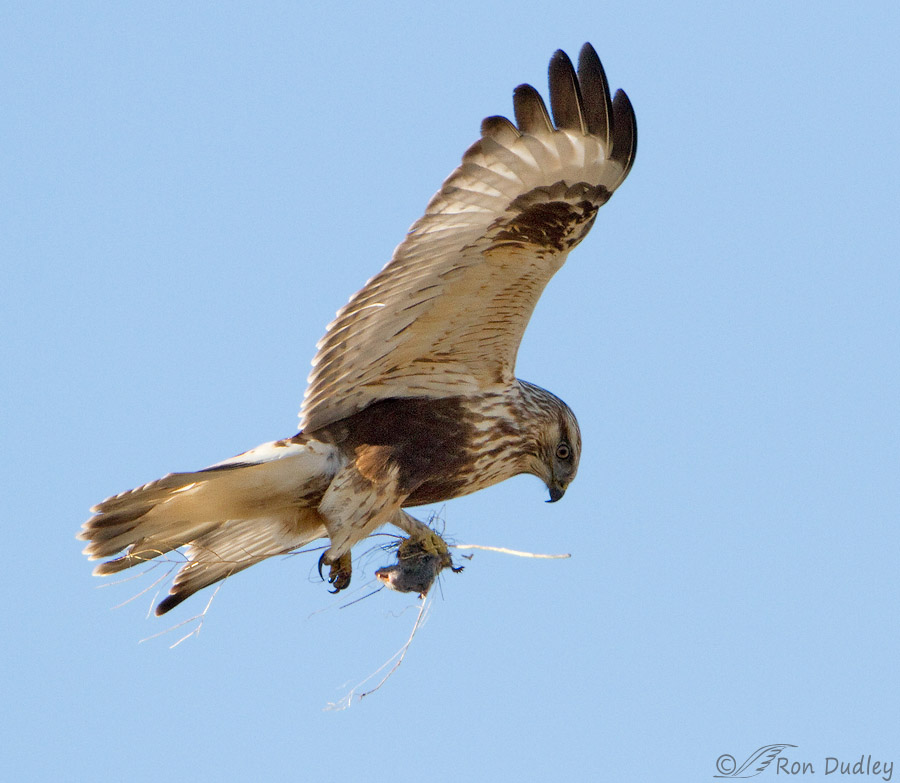
At first I focused on Roughies because they had been the subject of my conversation with Tom. In my experience Roughies primarily eat voles while they’re “down here” for the winter. This bird almost bit off more than he could chew with this feisty little vole that actually bit the hawk on the right foot. Those little rodent incisors are both nasty and sharp!
So how many rodents do Roughies actually eat? The Cornell Lab of Ornithology has this to say on the subject:
- “Nonbreeding adults eat about a quarter-pound of food daily, or a tenth of their body mass – that’s about 5 small mammals. Nestlings start feeding themselves (swallowing lemmings whole) at about 16 days old. It’s estimated that a brood of 2 nestlings requires 26 pounds of food during the 40 days between hatching to fledging.”
Various vole and mouse species average about 1 oz. in weight (lemmings in the arctic weigh a little more) so if you do the math every adult Roughie eats 4-5 small mammals every day (about 1460 annually) and two nestlings consume roughly 278 rodents in only their first 40 days. Clutch size is usually 3-5 eggs so the actual number of rodents consumed by nestlings is often much larger.
That’s a lot of rodents to bite the dust originating from only a single breeding pair of Rough-legged Hawks! But Roughies aren’t here in the breeding season so what about other raptor species that are here in the summer or year around?
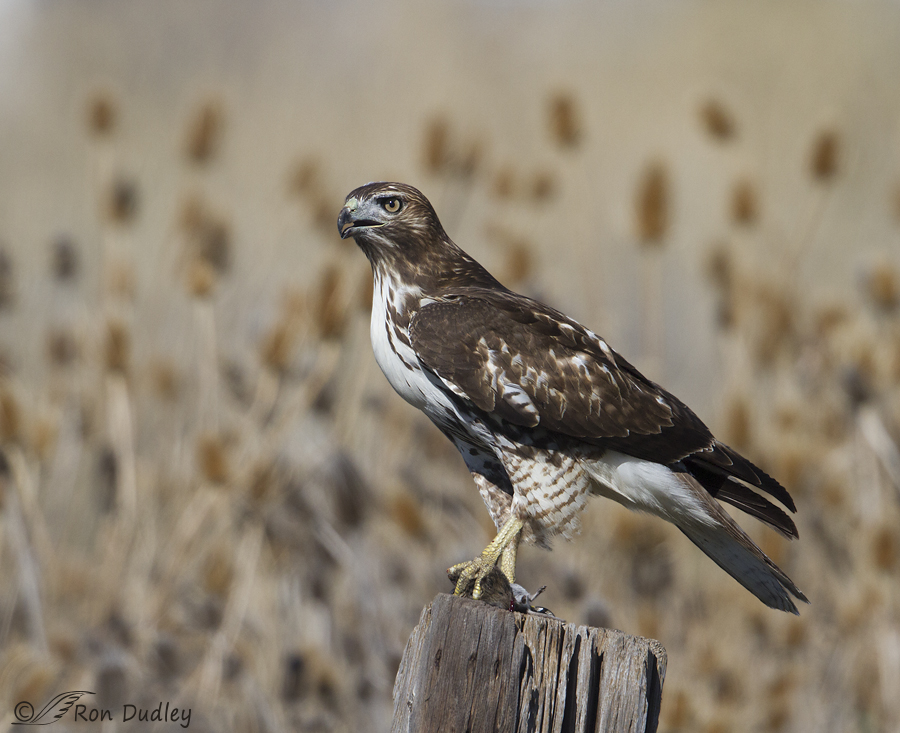
Red-tailed Hawks are voracious consumers of rodents and they’re here all year long, including breeding season. This one already had an enlarged crop from an earlier meal when I photographed it with yet another vole in its talons. I see red-tails eating voles and mice far more often than I see them eating anything else.
The Red-tailed Hawk is our most common, widespread, and well-known hawk and it’s larger than the Rough-legged Hawk so it seems logical to assume that they eat at least as many small mammals as Roughies do.
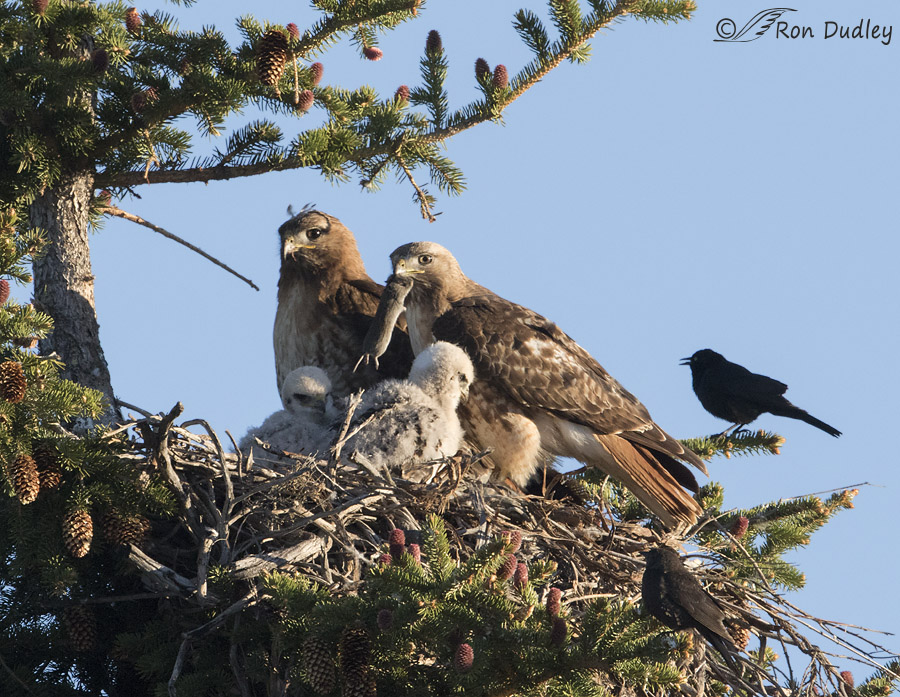
Here the male adult of a breeding pair of Red-tailed Hawks in Montana has just delivered a vole to his hungry chicks as his slightly larger mate looks on. It would take a lot of rodents to keep the ravenous youngsters satisfied through and even past fledging.
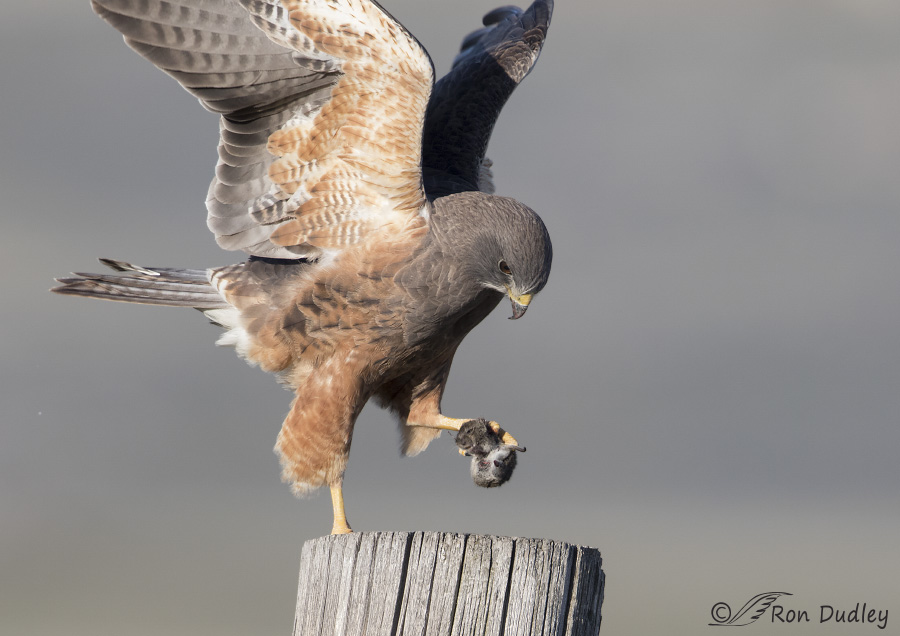
Many other species of buteos consume rodents also, including Swainson’s Hawks in summer. This Swainson’s is trying to avoid being bitten.
In addition to the buteos (soaring hawks) many other species of raptors prey on large numbers of rodents including some falcons and many owls. A single Barn Owl can consume about 1,500 rodents per year and a family of Barn Owls can prey on up to 25 rodents each and every night. No barn cat can even come close to those numbers.
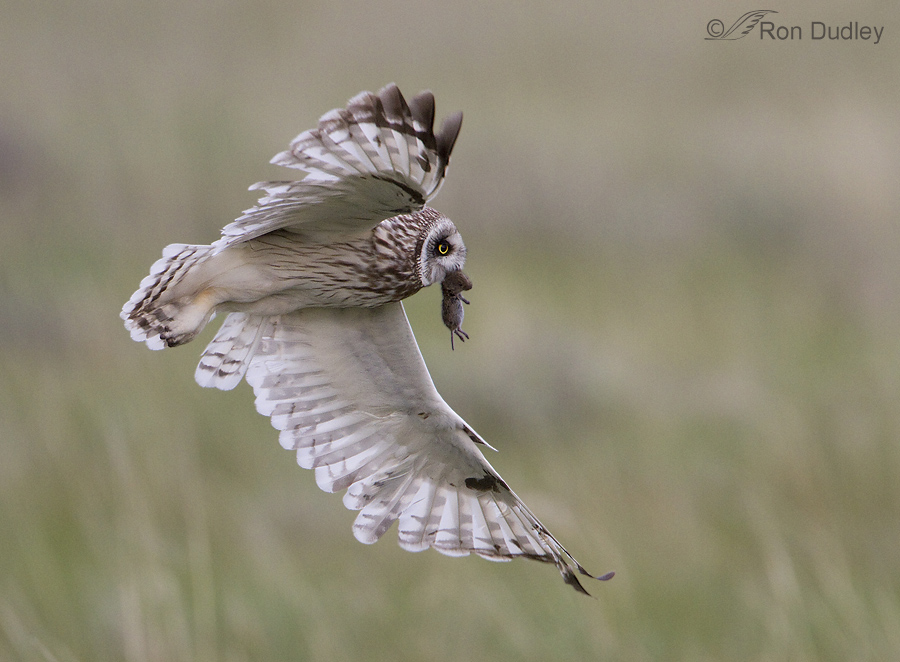
Short-eared Owls consume vast quantities of rodents.
Red-tailed Hawks, Swainson’s Hawks and Ferruginous Hawks are found in large numbers on our Montana family farm, especially during migration and the breeding season. They help immensely in keeping our ubiquitous Richardson’s Ground Squirrels (gophers) under control. Gophers can literally wipe out many acres of wheat and barley in the spring and early summer. And the Great Horned Owls living in our many old granaries are prolific consumers of both gophers and mice living in those old, mostly abandoned buildings.
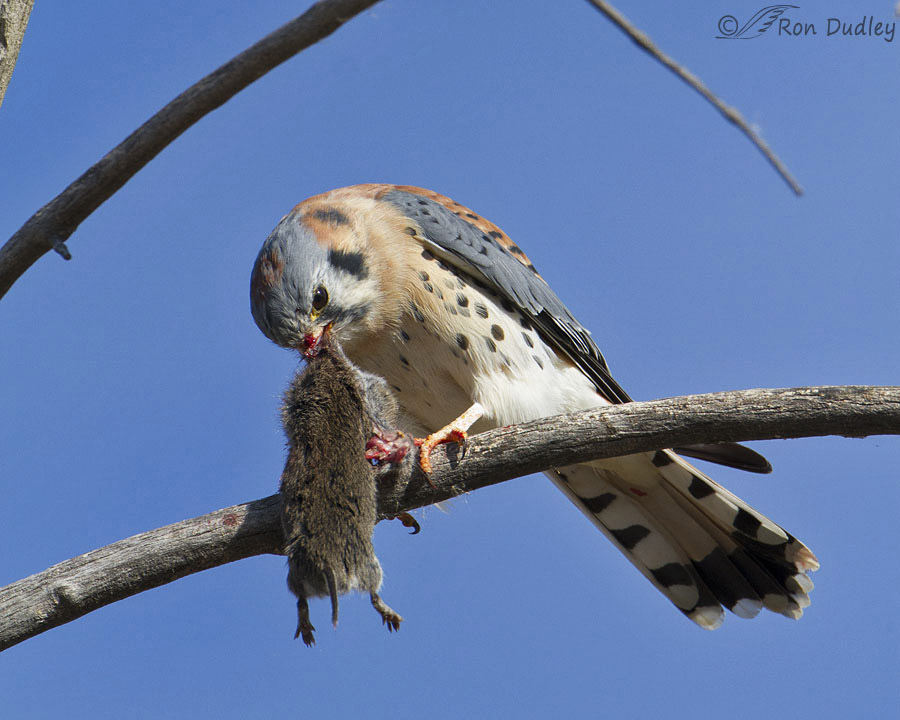
Some of the falcons are also efficient rodent killers. This male American Kestrel, our smallest falcon, is about to chow down on a vole.
And here we have a Prairie Falcon carrying off a ground squirrel (probably a Richardson’s Ground Squirrel).
So the next time you consider using chemicals (pesticides, rodenticides etc.) for rodent control please think again. Many raptors freely eat carrion and when they consume rodents killed by pesticides the raptor is likely to suffer the same horrendous, hemorrhagic death.
Raptors are our friends and they certainly don’t deserve such a fate.
Ron


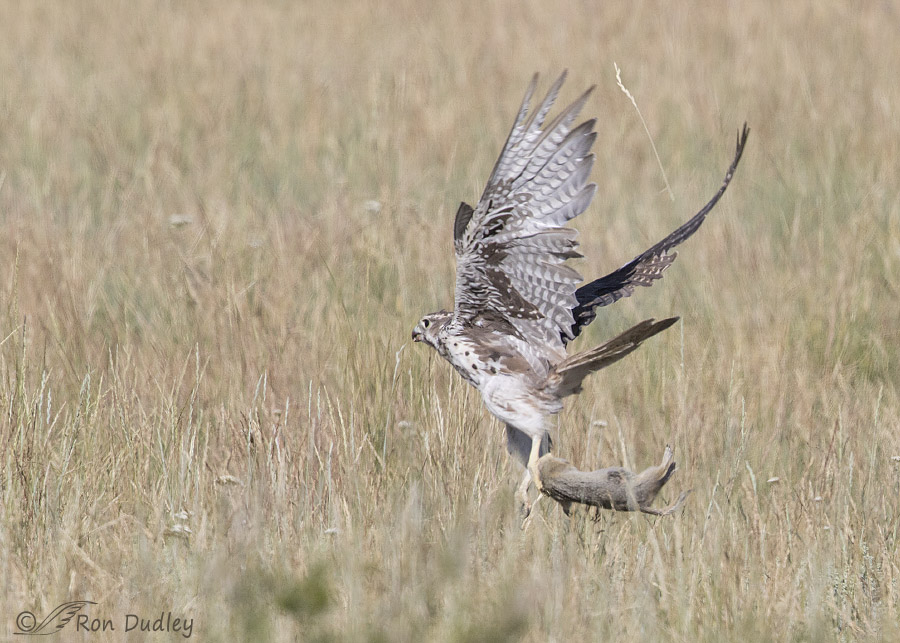
Thank you so much for this info. I’m a tour guide in the Canadian Rockies, and while I know a little about a lot of things, this is a wonderful summary
of raptors and their contribution to the environment. Excellent.
Fantastic info – thank you so much! We switched to snaptraps in our rural outbuildings and I did have to overcome some squeamishness but knowing that it’s the right thing to do makes it easy. And we’re working on sealing the areas where we have rodent intrusion so hopefully at some point we won’t even need traps.
When we moved from suburban to rural a few years ago there were boxes of d-con everywhere :(. I’m ashamed to say that we initially stuck with that method; I just didn’t understand how horrible those poisons are. The worst is that the rodents don’t die right away, so it’s not only an awful death for them but they get back outside and are eaten by the hawks and owls.
Anyway it was actually a bird (owl) photographer who made me realize the problem of the rodenticides and we got rid of them all immediately. We have GHO and kestrels and red tails and harriers all around and thoroughly enjoy them all :). The stats you’ve included on prey quantity are great and I can use that info when I visit vineyards and orchards to try and gently persuade. Thank you again!
People like you, willing to make changes when they understand what is needed, are my heroes.
Stunning series of photos today. Yes, I wish more people understood pest control is done without poisoning the whole ecosystem.
Thanks, April.
These are freakin gorgeous photos. In re rodent control see the film The Biggest Little Farm.
Thank you, Martha.
Ron, the abundance of useful information along with terrific photos makes this such a great post. Your blog has opened my eyes to so many things because of your vast knowledge and talent. You have some very special members of your Feathered Photography Club and I learn from them as well. Thanks for a great start to the New Year!!
“Feathered Photography Club”
I never thought of us as a club but I guess we kind of are. Thank you, Alice.
Thank you for this wonderful blog! We have shared it on our Facebook page. It would be wonderful to partner with you in some way.
Thanks for sharing, Lisa. I see from your email address that you’re with “Raptors Are The Solution” (RATS).
Yes, we are working to educate the public about the dangers of rodenticides to raptors (and other wildlife) and are also working to try to achieve better regulation of these products. We work through large-scale public education ads on billboards, buses, trains, etc. as well as through legislation and litigation.
Lisa, I’ve been aware of “RATS” as an organization for some time but I appreciate seeing precisely what your goals are. I support them wholeheartedly.
Thank you! Let me know if you have any ideas of ways in which we might partner sometime (of course the blog you have just posted is very very helpful, so thank you again
Lisa have you tried reaching out to the Wildlife Rehabilitation Center of Northern Utah to spread your flyers/information with them?
We do partner with lots of rehab centers but I had not heard of that one (we’re in CA). If you have a good contact there, please let me know, and thank you.
Boy, what great photos and what a great post!
I believe many if not most folks don’t think about the unintended consequences and food-chain victims that rodent poison can cause. They just want something effective to get rid of the rats or mice. Maybe the best we can do is to gently but clearly inform them of the downside to rodenticide use.
Every person I have spoken with (a few dozen) regarding this reacted positively and indicated they had never considered the damage caused and said they intended to avoid using the poison.
The raptor predation of rodents statistics in this great post are perfect info to enhance such learning opportunities.
I agree, Dave. Many don’t know about it so they don’t think about it. Education is the key. Thanks very much.
Eating a poisoned rodent is what killed, Wol, the GHO I raised ….people who put poison out have no way of knowing what other critters they might also kill….
I remember you mentioning how you lost your Great Horned, Patty. That must have been devastating for you.
Thank you, truly excellent information, Ron!
Thanks, Susan.
I really, really wish that poisons of one kind or another were not the go to solution for so many of ‘our’ problems. We so often create greater problems with their use.
Yet another great post.
And yes, the fires are still burning.
EC, yesterday I saw a map showing all the major active fires you’re having. Mind blowing…
I hadn’t seen that picture before of the paired Redtails on the nest, feeding the nestling. That is one great photo!
I’m glad you like it, John. Thanks.
Great post. Thanks for the nature study. I love all these learning opportunities.
Thank you, Betty.
Fascinating post and just astounding compilation of different raptors with prey.
Thanks, Lyle.
Raptors Are The Solution, mentioned by Nicky, above, has some figures. Last I read, a year or so ago, I think they estimated that an adult Barn Owl ate 1,000+ mice a year. This organization has been vital in getting vineyard owners to put up Barn Owl boxes. At the Raptor Center in Davis, CA, we fed adult Red-tails and Great Horned Owls 5 medium mice a day. A bird in the wild would need a bit more, I think.
Sallie, it would be interesting to find out how different food demands for captive raptors are versus for those in the wild.
From your picture to a readers comment to your next days post Love it!
And a very important and informative post at that. As someone else said thank you for gathering all of the information on the importance of these beautiful birds.
Recently I saw a box of rodent poison in a friends garage, boy did they get an ear full !
“From your picture to a readers comment to your next days post Love it!”
Diana, I never know where inspiration for a post will come from but it isn’t unusual for it to come from my readers.
Thanks for another excellent post, Ron. My second cup of coffee always feels more productive when I learn something! Well done, professor!
Thanks very much, Diane.
I don’t know if RATS – Raptors Are The Solution – based in Berkeley, CA, has some data? A former professor, who lives in Napa, has a resident red tailed whom she’s named “Ethan Hawk” who delights in capturing rodents when the green strip between the rows of grapevines is mowed! Rodenticides are awful and I’d like to see them banned permanently
Nicky, I think they should be banned to but with the current administration loosening up restrictions is more likely I’m afraid.
Perfect post, Ron! I hope many of your readers are in a position to utilize this wisdom or influence someone who is. And thanks to Tom Straw for asking his question. As you undoubtedly know, we’ve lost billions of birds for a variety of reasons in our adult lifetimes.
Have you considered looking into and talking about the impact on eagles, both golden and bald and all other raptors, of using lead ammunition to kill prairie dogs? Lead bullets fragment into tiny pieces when they hit an animal. And even tiny amounts of lead will affect the nervous system of a raptor sufficiently for it to become disabled and die. (Human nervous systems can also be impacted by lead from game meat as well, although the impacts are subtler, and most notably on young children and the elderly.) Lead in animals they scavenge is a significant reason that California condors have been threatened with extinction and now have to be periodically re-captured and tested for lead poisoning. Many of them have to be treated for lead poisoning before being released. There’s a lot of resources about this online. A good one is http://www.huntingwithnonlead.org/index.html
I’ve thought about it, Nancy. That ought to stir up some trouble…
Ron – thanks for taking the time to put together this very informative and educational post. Obviously they make a very important contribution to organic agriculture, but even in our typical suburban neighborhoods they are at work. A couple years ago I was photographing a Kestrel who was perched on top of my next door neighbor’s pine tree. Suddenly it took off and I thought it was gone, but within just a few seconds it was back with a mouse in its clutch. He dove down to the golf course, caught the now bloody mouse and returned to the top of the tree where I took more photos of him. And I would assume that our local owls are busy at night keeping the Pack Rat population under control.
Yup, there’s more raptors, in more places, than lots of folks think. Thanks, Everett.
A fantastic collection of photos in today’s blog. Thanks, Ron!
Thank you, Dan.
The solution may be to drive out there and try to get a shot of one.I would like to see the old place once again anyway,reluctantly had to sell it in a divorce.
Good idea! And yes, I get that divorce thing…
Good morning Ron,i feel kinda silly believing those birds were Roughies for the last 20 years! The only good camera i had at that time was an old canon ae-1 and it was 40 miles to town to get the film developed so, i didn’t use it.Just for info the property was 6400ft.alt. at about the same latitude as PROVO,rolling grasslands,a creek on the west side that went dry in mid summer,and 2 ponds that had water all year.large grove of cottonwoods all along the creek.Also had a pair of Great Horn owls that came over from the creek at night.There were other raptors in the area but none seem to hunt close to the farm.I remember the nesting birds had a white band at the base of the tail and a dark band at the end.Would see them leaving the alfalfa field several times a day with 13 striped ground squirrels,they seemed to labor a little on takeoff with the weight.The squirrels were about the size of a chipmunk.They were also fond of snakes and would get the ones that were caught in the mower after i cut hay. they raised about 2 young every year,once i remember 3.Bodies were mostly red marbled with red and white on the head (not as much white as a Roughy)I am really curious as to what they were?
Tom, without a photo I can’t be confident of an ID because there’s so much variation in raptor plumages.
Thanks again for the inspiration for this post.
Ron, great discussion on economic value – I was told when a small town lost its pair of great horned owls the squirrels exploded. On my farm in eastern Iowa, we have recently observed about 20 small rodents hanging in the 4 year old trees & shrubs. While not yet seen, it has to be the work of a Northern Shrike. http://www.larkfields.org has a photo.
Yup, sounds like shrikes to me, Ann.
Excellent! They are efficient rodent control – snakes are helpful with that also even if some of them aren’t my “favorite” creatures….
They are efficient rodent control – snakes are helpful with that also even if some of them aren’t my “favorite” creatures….  Thx for the research, Ron. Interesting to me that there are things I “know” but just don’t think much about their significance…….
Thx for the research, Ron. Interesting to me that there are things I “know” but just don’t think much about their significance…….
Good point about snakes, Judy. Thanks.